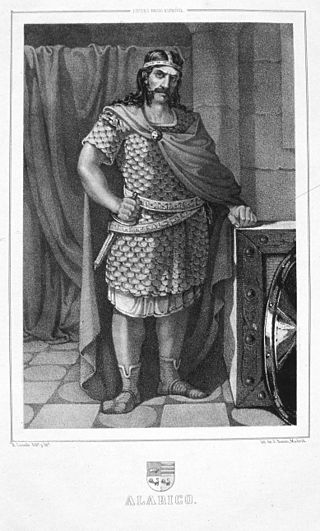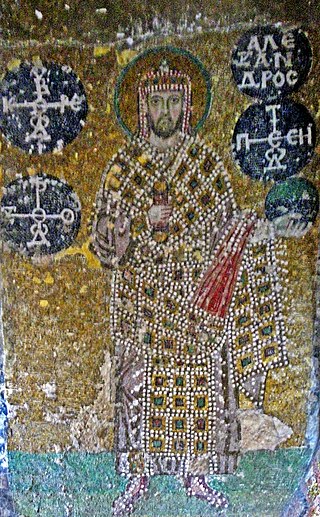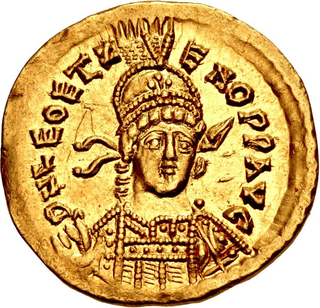The 470s decade ran from January 1, 470, to December 31, 479.
The 480s decade ran from January 1, 480, to December 31, 489.
The 460s decade ran from January 1, 460, to December 31, 469.

Year 457 (CDLVII) was a common year starting on Tuesday of the Julian calendar. At the time, it was known as the Year of the Consulship of Constantinus and Rufus. The denomination 457 for this year has been used since the early medieval period, when the Anno Domini calendar era became the prevalent method in Europe for naming years.

Year 484 (CDLXXXIV) was a leap year starting on Sunday of the Julian calendar. At the time, it was known as the Year of the Consulship of Venantius and Theodoricus. The denomination 484 for this year has been used since the early medieval period, when the Anno Domini calendar era became the prevalent method in Europe for naming years.

Year 475 (CDLXXV) was a common year starting on Wednesday of the Julian calendar. At the time, it was known as the Year of the Consulship of Zeno without colleague. The denomination 475 for this year has been used since the early medieval period, when the Anno Domini calendar era became the prevalent method in Europe for naming years.

Year 473 (CDLXXIII) was a common year starting on Monday of the Julian calendar. At the time, it was known as the Year of the Consulship of Leo without colleague. The denomination 473 for this year has been used since the early medieval period, when the Anno Domini calendar era became the prevalent method in Europe for naming years.

Glycerius was Roman emperor of the West from 473 to 474. He served as comes domesticorum during the reign of Olybrius, until Olybrius died in November 472. After a four-month interregnum, Glycerius was proclaimed as emperor in March 473 by Gundobad, the magister militum and power behind the throne. Very few of the events of his reign are known other than that an attempted invasion of Italy by the Visigoths was repelled by local commanders, diverting them to Gaul. Glycerius also prevented an invasion by the Ostrogoths through diplomacy, including a gift of 2,000 solidi.

Year 912 (CMXII) was a leap year starting on Wednesday of the Julian calendar.

Julius Nepos, or simply Nepos, ruled as Roman emperor of the West from 24 June 474 to 28 August 475. After losing power in Italy, Nepos retreated to his home province of Dalmatia, from which he continued to claim the western imperial title, with recognition from the Eastern Roman Empire, until he was murdered in 480. Though Nepos' successor in Italy, Romulus Augustulus, is traditionally deemed the last western Roman emperor, Nepos is regarded by some historians as the true last emperor of the west, being the last widely recognised holder of the position.

Year 467 (CDLXVII) was a common year starting on Sunday of the Julian calendar. At the time, it was known as the Year of the Consulship of Pusaeus and Iohannes. The denomination 467 for this year has been used since the early medieval period, when the Anno Domini calendar era became the prevalent method in Europe for naming years.

Leo I, also known as "the Thracian", was Eastern Roman emperor from 457 to 474. He was a native of Dacia Aureliana near historic Thrace. He is sometimes surnamed with the epithet "the Great", probably to distinguish him from his young grandson and co-augustus Leo II.

Zeno was Eastern Roman emperor from 474 to 475 and again from 476 to 491. His reign was plagued by domestic revolts and religious dissension, but was more successful on the foreign front. He is credited with further stabilizing the Eastern empire, while the Western Roman Empire fell following the deposition of Romulus Augustulus.

Leo II, called the Younger, briefly ruled as emperor of the Eastern Roman Empire from 473 to 474. He was the son of Zeno, the Isaurian general and future emperor, and Ariadne, a daughter of the emperor Leo I. Leo II was made co-emperor with his grandfather Leo I on 17 November 473, and became sole emperor on 18 January 474 after Leo I died of dysentery. His father Zeno was made co-emperor by the Byzantine Senate on 29 January, and they co-ruled for a short time before Leo II died in late 474.

The Leonid dynasty or Thracian dynasty produced six Roman emperors during Late Antiquity, reigning over the Roman Empire from 457 to 518. The dynasty's patriarch was Leo I, who was made Roman emperor in 457. Leo's daughter Ariadne became empress and mother to an emperor, and her two husbands were themselves each made emperor in turn. Another relative whose name does not survive of Leo I or his wife Verina married the future augustus Julius Nepos, the last emperor in the Western Roman Empire. The dynasty of Leo succeeded the preceding Valentinianic dynasty and Theodosian dynasty whose family trees were conjoined and ruled concurrently. Besides Julius Nepos, who administered no more than a rump state the Roman province of Dalmatia in the western empire during the fall of the west, the dynasty's emperors governed the eastern empire.
Ovida or Odiva was a late Western Roman general and warlord of likely Gothic origin and the last Roman ruler of Dalmatia. Ovida initially served Julius Nepos, ruler of Roman Dalmatia and later western Roman emperor in Italy from 474 to 475. After being usurped in 475, Nepos continued to claim the imperial title in exile in Dalmatia, supported by the Eastern Roman Empire, but he was murdered by Ovida and another general, Viator, in 480. Upon his death, Ovida became the ruler of Dalmatia, a position he held until he was defeated and killed by Odoacer, the first barbarian King of Italy, in 481 or 482.

The origins of the word domesticus can be traced to the late 3rd century of the Late Roman army. They often held high ranks in various fields, whether it was the servants of a noble house on the civilian side, or a high-ranking military position. After serving under the emperor for a certain duration, the Domestici would be able to become leaders themselves and potentially command their own regiment of legionaries in the military. Relatively, the most important offices were the “Comes Domesticorum” also known as, “Commander of the Protectores Domestici,” and “Comes rei Militaris” or General.

Marcus was the son of the Eastern Roman general and usurper Basiliscus and Zenonis. He was acclaimed caesar in 475 and later promoted to augustus, ruling as junior co-emperor to his father. When Zeno reoccupied Constantinople in late August 476, Marcus, with his parents, hid in a church. Zeno swore he would not spill their blood, and instead had them exiled to Limnae in Cappadocia, where they were then starved to death.
Basiliscus was the only son of the Eastern Roman military commander Armatus and was briefly caesar of the Eastern Roman Empire in 476–477/478. After the death of Eastern Roman Emperor Leo in 474, his grandson Leo II took the throne. Leo II died in the same year and his father, Zeno, ascended the throne. Soon after Zeno's ascension, Basiliscus' great-uncle, similarly named Basiliscus, forced Zeno into exile and took the throne himself. However, Basiliscus soon lost support with Armatus, who betrayed him by arranging a deal with Zeno: Armatus would hold the rank of magister militum praesentalis for life, and the younger Basiliscus would be made caesar. Caesar was a senior imperial title, and implied that the holder was the heir to the throne. Although Basiliscus was crowned in late 476, Zeno soon moved against Basiliscus's father, executing Armatus and exiling Basiliscus to Blachernae on the Golden Horn as a church lector. Later in his life, Basiliscus became a priest and the bishop of Cyzicus. He may have survived into the reign of Justinian.

The Eastern Roman Empire was ruled by the House of Leo from AD 457, the accession of Leo I, to 518, the death of Anastasius I. The rule of the Leonid dynasty coincided with the rapid decline, collapse and eventual fall of the Western Roman Empire. Following the end of the Western Empire, Emperor Zeno abolished the position of Western Roman Emperor and declared himself the sole Roman Emperor. The Eastern Roman Empire would come to last for several more centuries, and subsequent dynasties would invest large amounts of resources in attempts to retake the western provinces.














